Antisymmetric Lamb Wave Simulation Study Based on Electromagnetic Acoustic Transducer with Periodic Permanent Magnets
Abstract
:1. Introduction
2. Configuration and Working Principle of EMATs
2.1. HP-PPM-EMAT
2.2. Working Principle of EMATs
3. FEM and Simulation Analysis of EMATs
3.1. Established the FEMs
3.2. Analysis of Static Magnetic Field
3.3. Analysis of Lorentz Force Field
3.4. Analysis of Signal of EMATs
4. Optimization of EMATs
4.1. Orthogonal Test Design
4.2. Analysis the Results of the Orthogonal Test Design
4.3. Improvement in the Width of Magnet Units
5. Conclusions
Author Contributions
Funding
Institutional Review Board Statement
Informed Consent Statement
Data Availability Statement
Conflicts of Interest
References
- Ribichini, R.; Nagy, P.B.; Ogi, H. The impact of magnetostriction on the transduction of normal bias field EMATs. Ndt E Int. 2012, 51, 8–15. [Google Scholar] [CrossRef]
- Liu, S.; Li, L.; Cai, Z.; Zhang, C.; Yang, Q. Design of electromagnetic interference elimination circuit in electromagnetic ultrasonic detection system. J. Electrotech. Technol. 2016, 31, 80–84. [Google Scholar]
- Hernandez-Valle, F.; Dixon, S. Initial tests for designing a high temperature EMAT with pulsed electromagnet. NDT E Int. 2010, 43, 171–175. [Google Scholar] [CrossRef]
- Kogia, M.; Gan, T.-H.; Balachandran, W.; Livadas, M.; Kappatos, V.; Szabo, I.; Mohimi, A.; Round, A. High temperature shear horizontal electromagnetic acoustic transducer for guided wave inspection. Sensors 2016, 16, 582. [Google Scholar] [CrossRef] [Green Version]
- Sun, H.; Peng, L.; Wang, S.; Wang, Q.; Zhao, W.; Huang, S. Effective focal area dimension optimization of shear horizontal point-focusing EMAT using orthogonal test method. IEEE Trans. Instrum. Meas. 2021, 70, 9508608. [Google Scholar] [CrossRef]
- Zhang, H.; Cao, Y.; Yu, J.; Chen, X. Selection of single-mode Lamb wave excitation frequency using a single piezoelectric sensor. J. Phys. 2011, 60, 377–385. [Google Scholar]
- Deng, M.; Xiang, Y. Time-domain analysis of second-harmonic generation of primary Lamb wave propagation in an elastic plate. Chin. Phys. B 2010, 19, 114302. [Google Scholar] [CrossRef]
- Xiang, Y.; Deng, M. Cumulative second-harmonic generation of Lamb waves propagating in a two-layered solid plate. Chin. Phys. B 2008, 17, 4232. [Google Scholar]
- Khalili, P.; Cawley, P. Relative ability of wedge-coupled piezoelectric and meander coil EMAT probes to generate single-mode Lamb waves. IEEE Trans. Ultrason. Ferroelectr. Freq. Control. 2018, 65, 648–656. [Google Scholar] [CrossRef]
- Zhang, X.; Li, W.; Li, B.; Tu, J.; Liao, C.; Wu, Q.; Feng, S.; Song, X. A new design of the dual-mode and pure longitudinal EMAT by using a radial-flux-focusing magnet. Sensors 2022, 22, 1316. [Google Scholar] [CrossRef]
- Liu, Z.; Li, A.; Zhang, Y.; Deng, L.; Wu, B.; He, C. Development of a directional magnetic-concentrator-type electromagnetic acoustic transducer for ultrasonic guided wave inspection. Sens. Actuators A Phys. 2020, 303, 111859. [Google Scholar] [CrossRef]
- Guo, X.; Zhu, W.; Qiu, X.; Xiang, Y. A Lorentz force EMAT design with racetrack coil and periodic permanent magnets for selective enhancement of ultrasonic Lamb wave generation. Sensors 2022, 23, 96. [Google Scholar] [CrossRef]
- Liu, S.; Zhang, Y.; Zhang, C.; Jin, L.; Yang, Q. Research on Excitation Method of Single-Mode Lamb Wave Based on Electromagnetic Acoustic Double Transducer. J. Electr. Eng. Technol. 2018, 33, 140–147. [Google Scholar] [CrossRef]
- Wilcox, P.D.; Lowe, M.J.S.; Cawley, P. The excitation and detection of Lamb waves with planar coil electromagnetic acoustic transducers. IEEE Trans. Ultrason. Ferroelectr. Freq. Control. 2005, 52, 2370–2383. [Google Scholar] [CrossRef]
- Yang, X.; Zhang, W.; Wu, Y.; Wu, Y.; Zhang, T. An EMAT for improving the purity and amplitude of S0 Lamb waves. Meas. Sci. Technol. 2022, 33, 095114. [Google Scholar] [CrossRef]
- Sun, W.; Liu, G.; Xia, H.; Xia, Z. A modified design of the omnidirectional EMAT for antisymmetric Lamb wave generation. Sens. Actuators A: Phys. 2018, 282, 251–258. [Google Scholar] [CrossRef]
- Jiao, J.; Zhang, Y.; Sun, J.; He, C.; Wu, B. Design of low-frequency single A0 modal piezoelectric transducer and its application in the non-destructive testing of plate structure. J. Mech. Eng. 2012, 48, 7–13. [Google Scholar] [CrossRef]
- Zhai, G.; Jiang, T.; Kang, L.; Wang, S. Minimizing influence of multi-modes and dispersion of electromagnetic ultrasonic Lamb waves. IEEE Trans. Ultrason. Ferroelectr. Freq. Control. 2010, 57, 2725–2733. [Google Scholar] [CrossRef]
- Li, M.; Deng, M.; Gao, G. Selective generation of ultrasonic Lamb waves by electromagnetic acoustic transducers. Chin. Phys. B 2016, 25, 124301. [Google Scholar] [CrossRef]
- Kang, L.; Wang, S.; Jiang, T.; Zhai, G. Optimal design of Lamb wave electromagnetic acoustic transducers for improving their excitation performance. Jpn. J. Appl. Phys. 2011, 50, 07HD01. [Google Scholar] [CrossRef]
- Liu, S.; Zhang, Y.; Huo, D.; Zhang, C.; Cai, Z.; Yang, Q. Finite element analysis and optimal design of Lamb wave EMATs for aluminum plates. J. Chongqing Univ. 2016, 39, 71–77. [Google Scholar]
- Kubrusly, A.C.; Freitas, M.A.; von der Weid, J.P.; Dixon, S. Mode selectivity of SH guided waves by dual excitation and reception applied to mode conversion analysis. IEEE Trans. Ultrason. Ferroelectr. Freq. Control. 2018, 65, 1239–1249. [Google Scholar] [CrossRef] [Green Version]
- Cui, Y.; Zhang, Y.; Hu, Z.; Qian, Z.; Ma, Z. An SH0-wave-based electromagnetic acoustic transducer and its experimental investigation. Piezoelectr. Acoustooptics 2021, 43, 443–448. [Google Scholar]
- Zhang, Y.; Qian, Z.; Wang, B. Modes control of Lamb wave in plates using meander-line electromagnetic acoustic transducers. Appl. Sci. 2020, 10, 3491. [Google Scholar] [CrossRef]
- Sun, H.; Wang, S.; Huang, S.; Peng, L.; Wang, Q.; Zhao, W.; Zou, J. Point-focusing shear-horizontal guided wave EMAT optimization method using orthogonal test theory. IEEE Sens. J. 2020, 20, 6295–6304. [Google Scholar] [CrossRef]
- Zhang, J.; Liu, M.; Jia, X.; Gao, R. Numerical study and optimal design of the butterfly coil EMAT for signal amplitude enhancement. Sensors 2022, 22, 4985. [Google Scholar] [CrossRef]
- Jia, X.; Ouyang, Q. Optimal design of point-focusing shear vertical wave electromagnetic ultrasonic transducers based on orthogonal test method. IEEE Sens. J. 2018, 18, 8064–8073. [Google Scholar] [CrossRef]
- Stojanovic, V.; Nedic, N.; Prsic, D.; Dubonjic, L. Optimal experiment design for identification of ARX models with constrained output in non-Gaussian noise. Appl. Math. Model. 2016, 40, 6676–6689. [Google Scholar] [CrossRef]
- Grondel, S.; Paget, C.; Delebarre, C.; Assaad, J.; Levin, K. Design of optimal configuration for generating A0 Lamb mode in a composite plate using piezoceramic transducers. J. Acoust. Soc. Am. 2002, 112, 84–90. [Google Scholar] [CrossRef]
- Hirao, M.; Ogi, H. Coupling Mechanism. In Electromagnetic Acoustic Transducers: Noncontacting Ultrasonic Measurements Using EMATs, 2nd ed.; Springer: Tokyo, Japan, 2017; pp. 15–38. [Google Scholar]
- Guo, Z.; Li, S.; He, H.; Yang, Y.; Zhang, Q. Research on single mode excitation method of Lamb wave based on electromagnetic ultrasonic transducer. Chin. J. Sci. Instrum. 2021, 42, 253–260. [Google Scholar] [CrossRef]
- Liu, L. Study on Acoustic Field Characteristics of Direct Conductor EMAT Phased Array Synthesis Radiation. Master’s Thesis, North Central University, Taiyuan, China, 2021. [Google Scholar] [CrossRef]
- Zhang, J.; Zhao, L.; Shi, W.; Wang, X.; Dong, Z. Optimization design of excitation performance of meander coil electromagnetic acoustic transducer. Chin. J. Sens. Technol. 2019, 32, 1182–1188. [Google Scholar]
- Gao, S.; Lu, B.; Nouredine, F.; Liao, H. Fabrication of FeNi Permalloy by Laser Additive Materials and Their Magnetic Properties. Mater. Res. Appl. 2021, 15, 341–349. [Google Scholar]

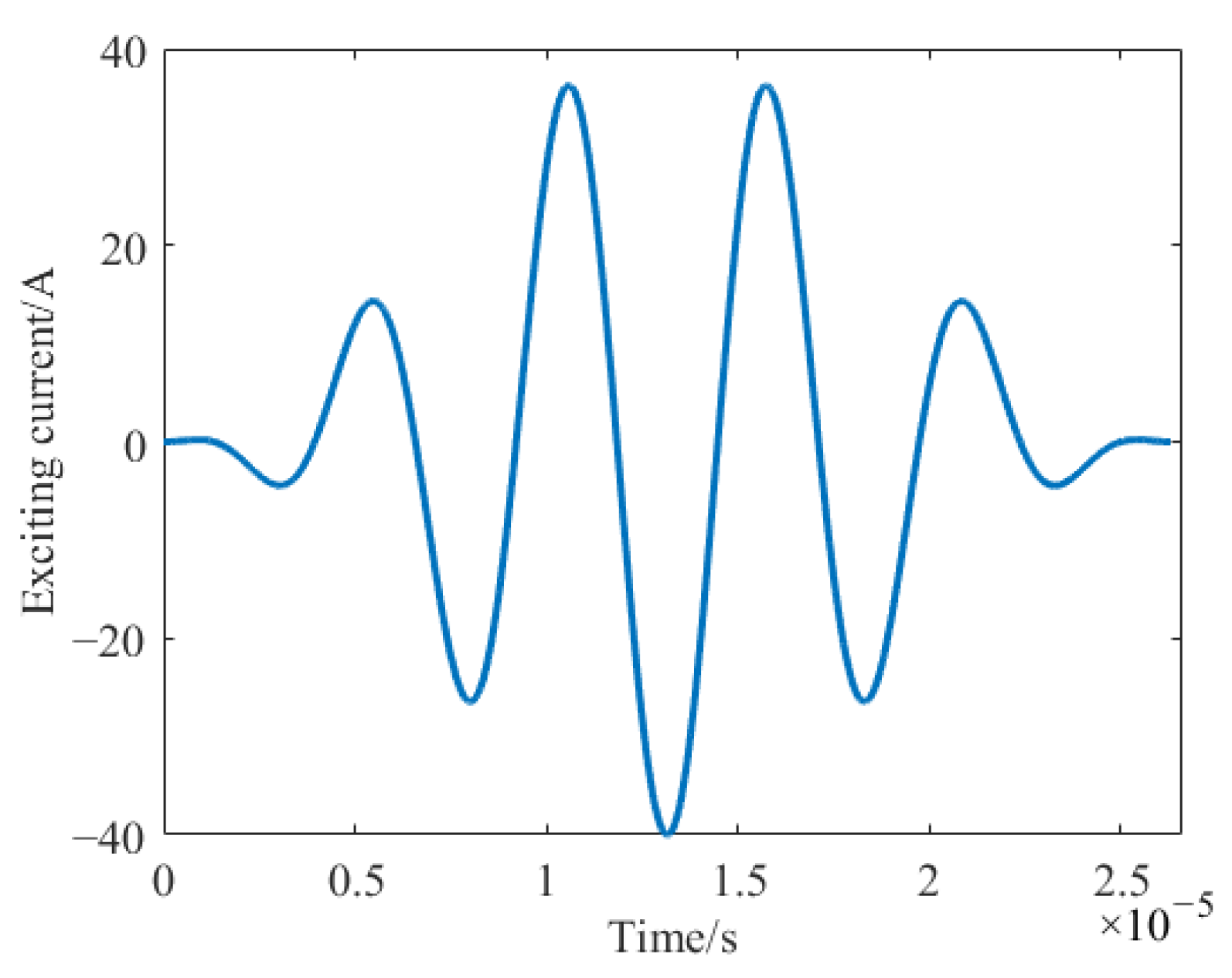
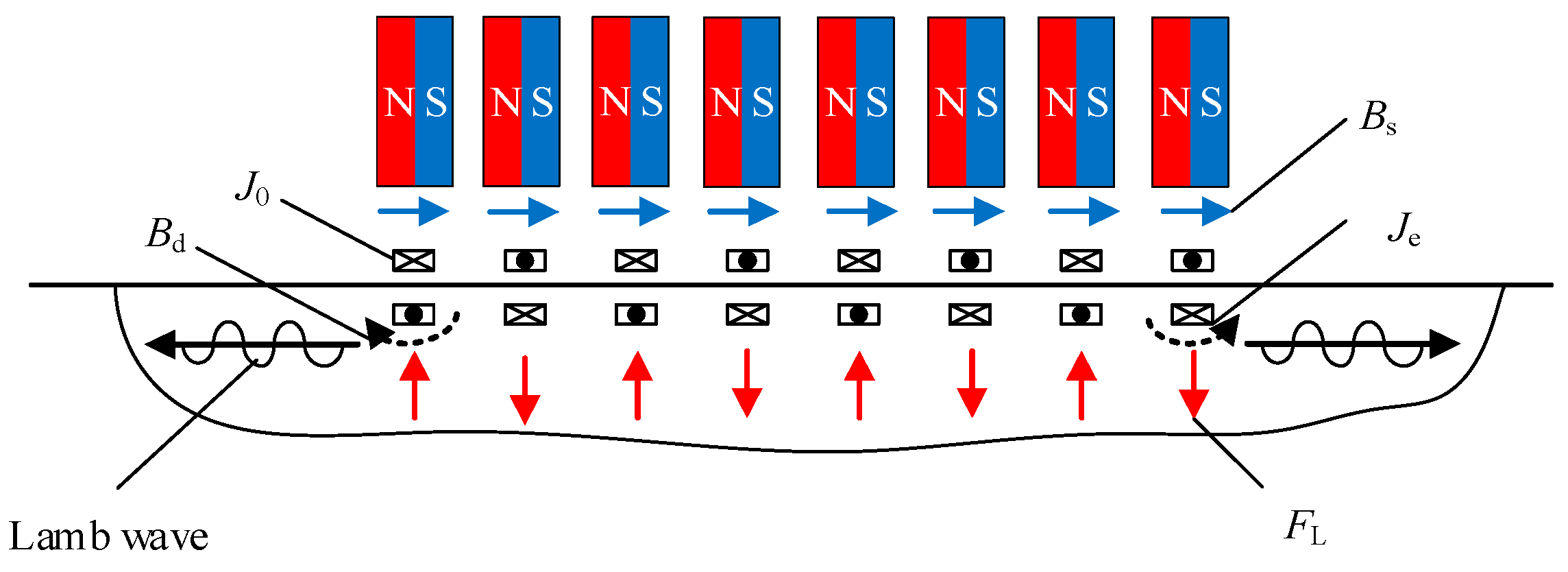
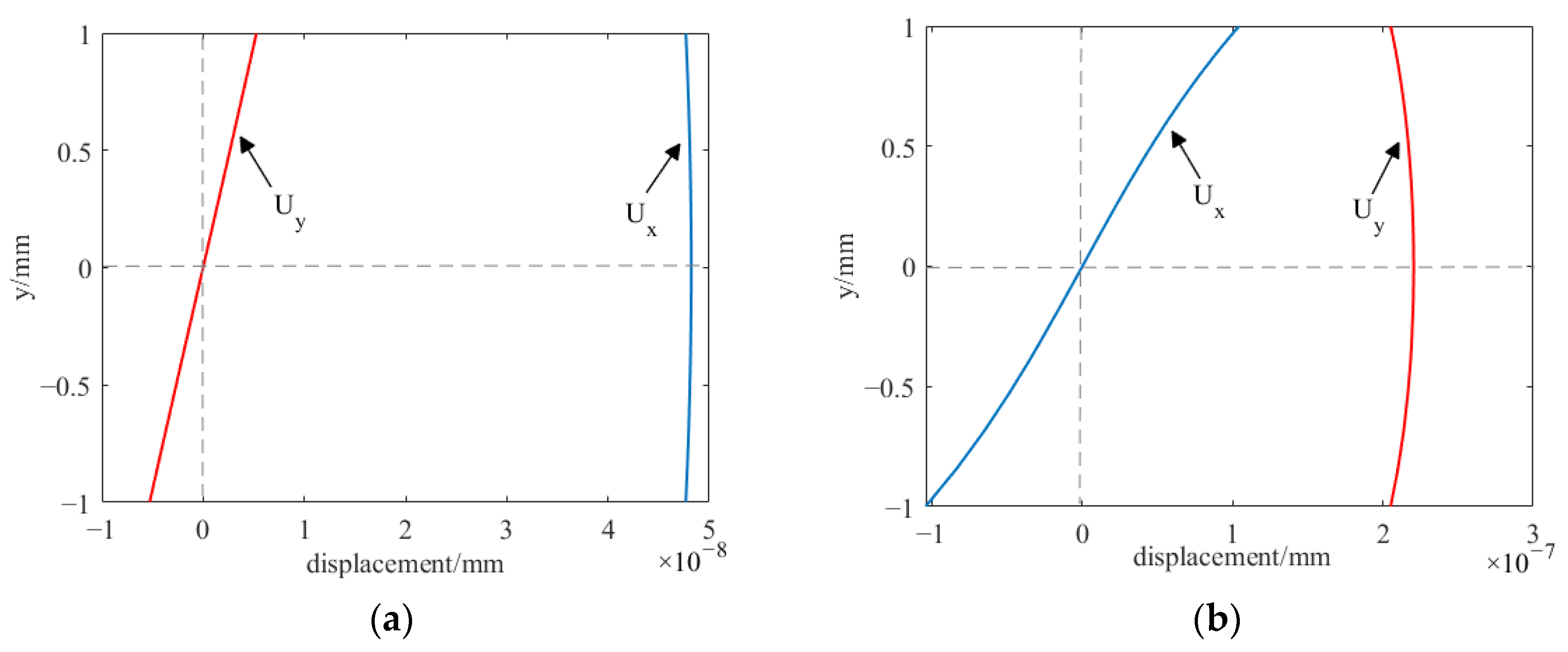
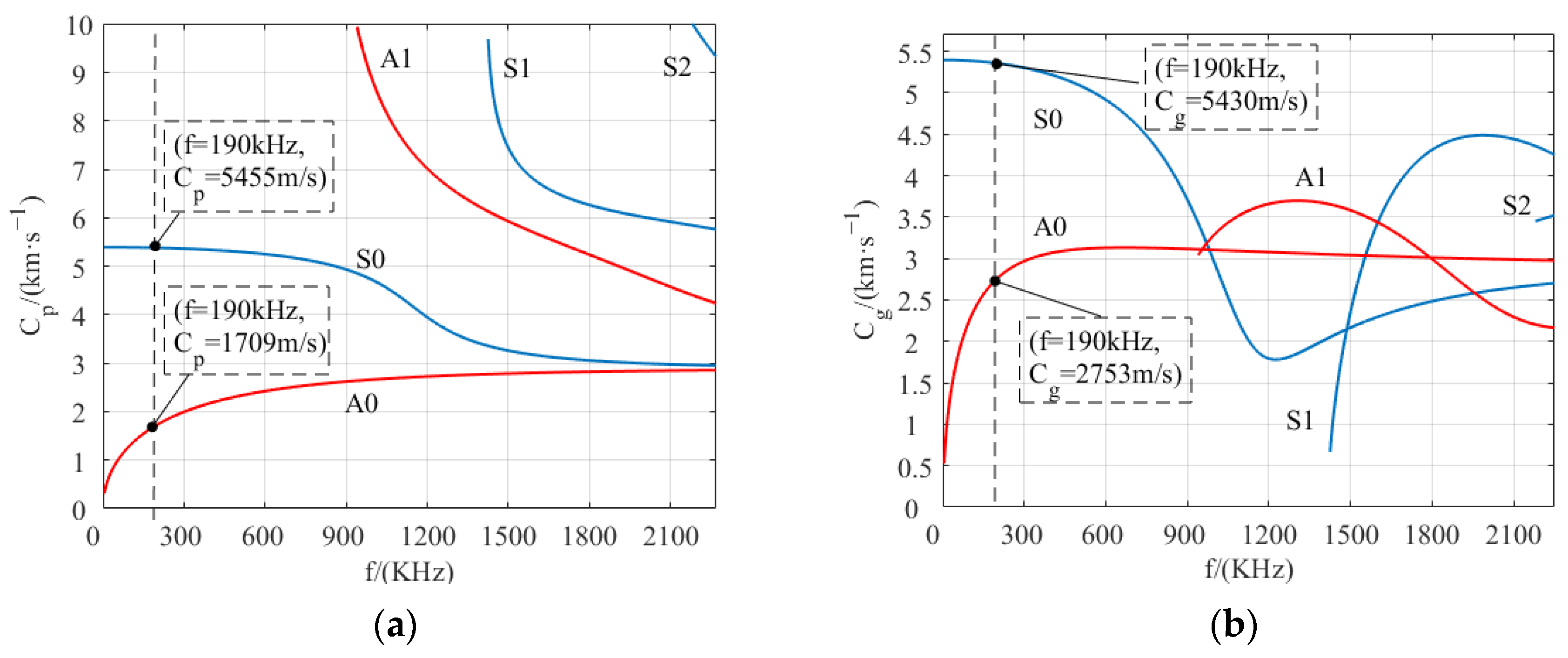



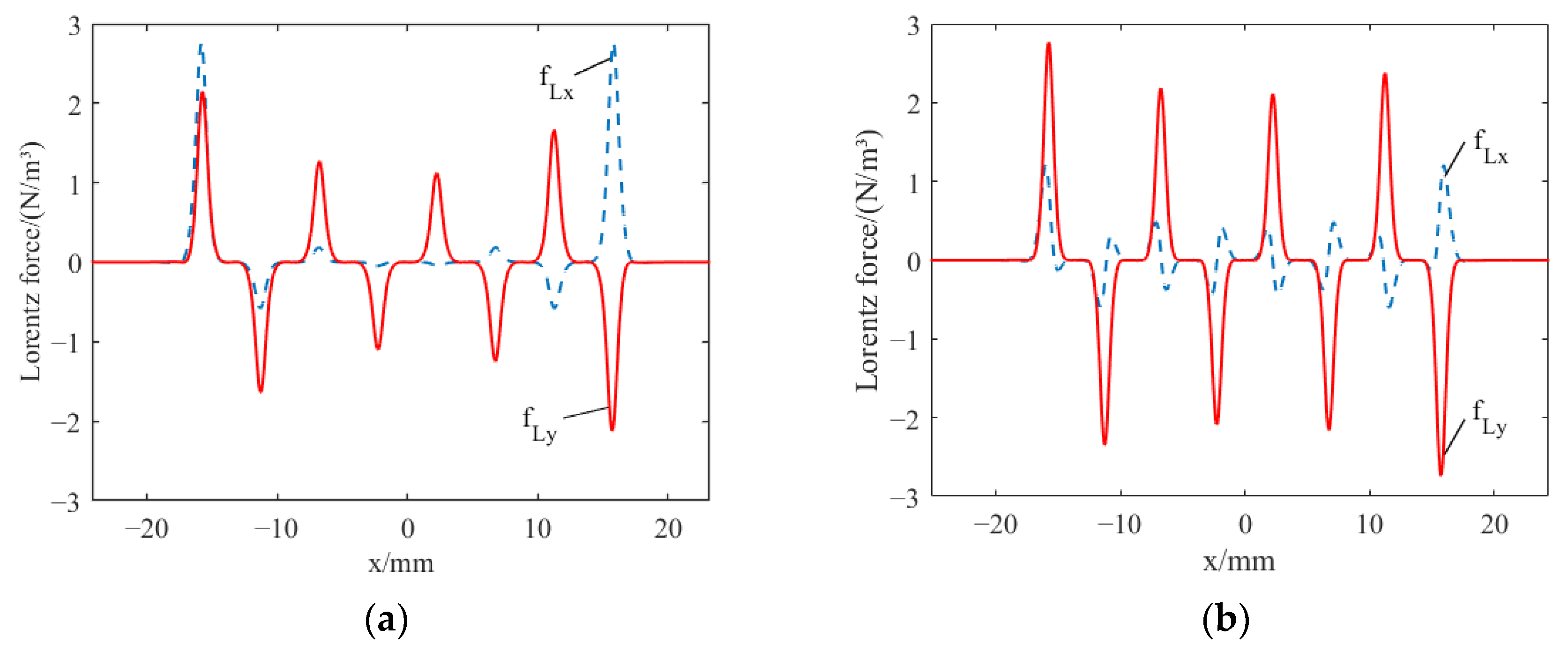
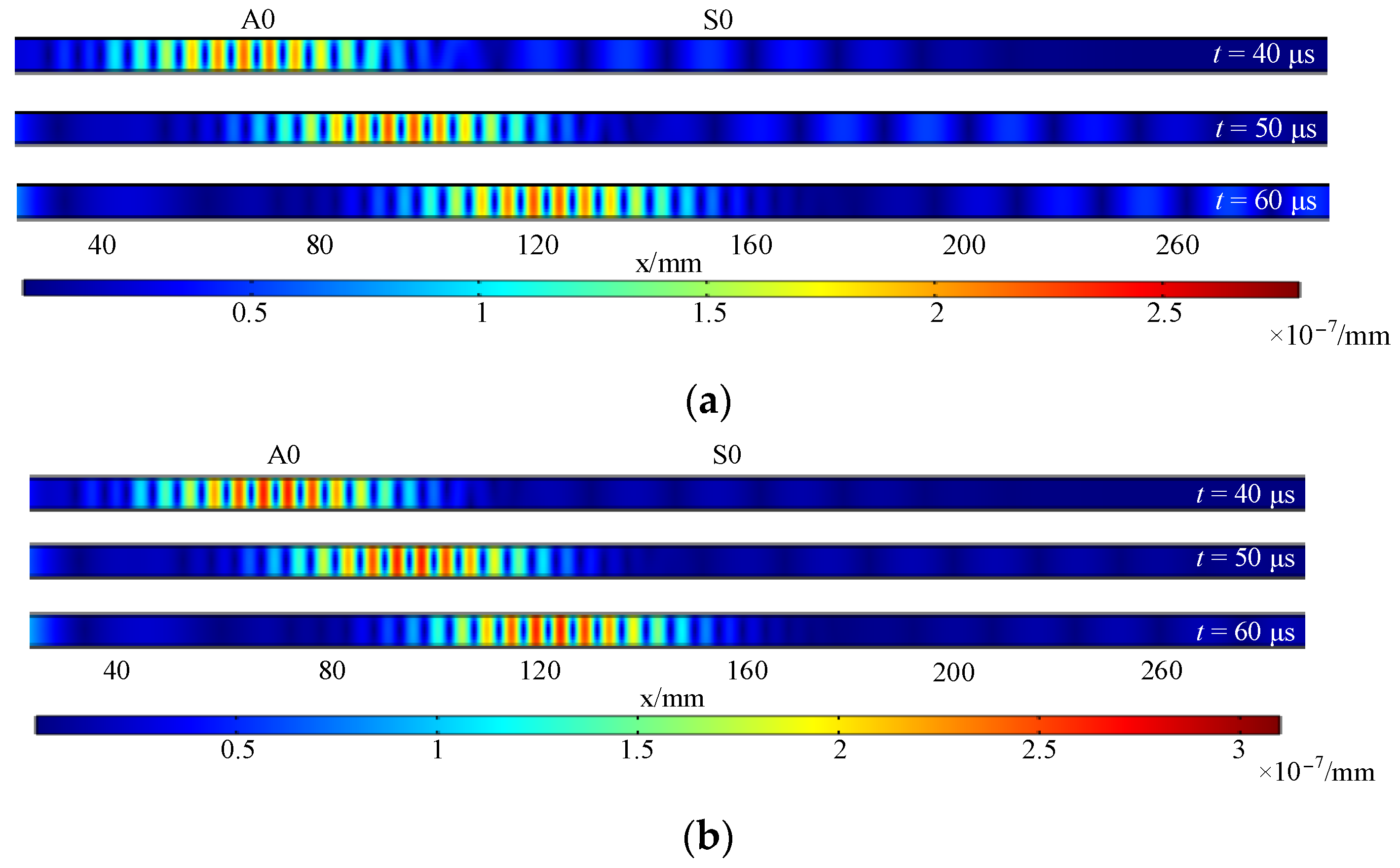

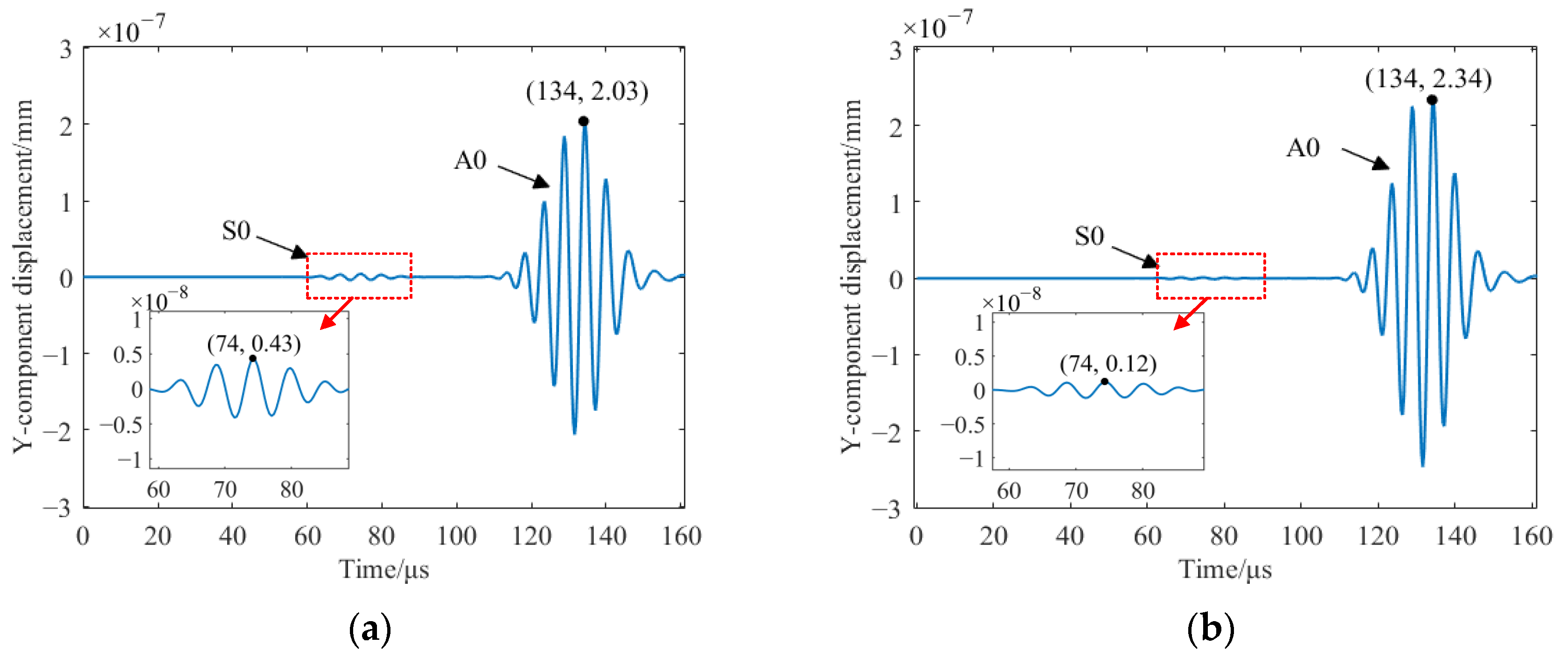
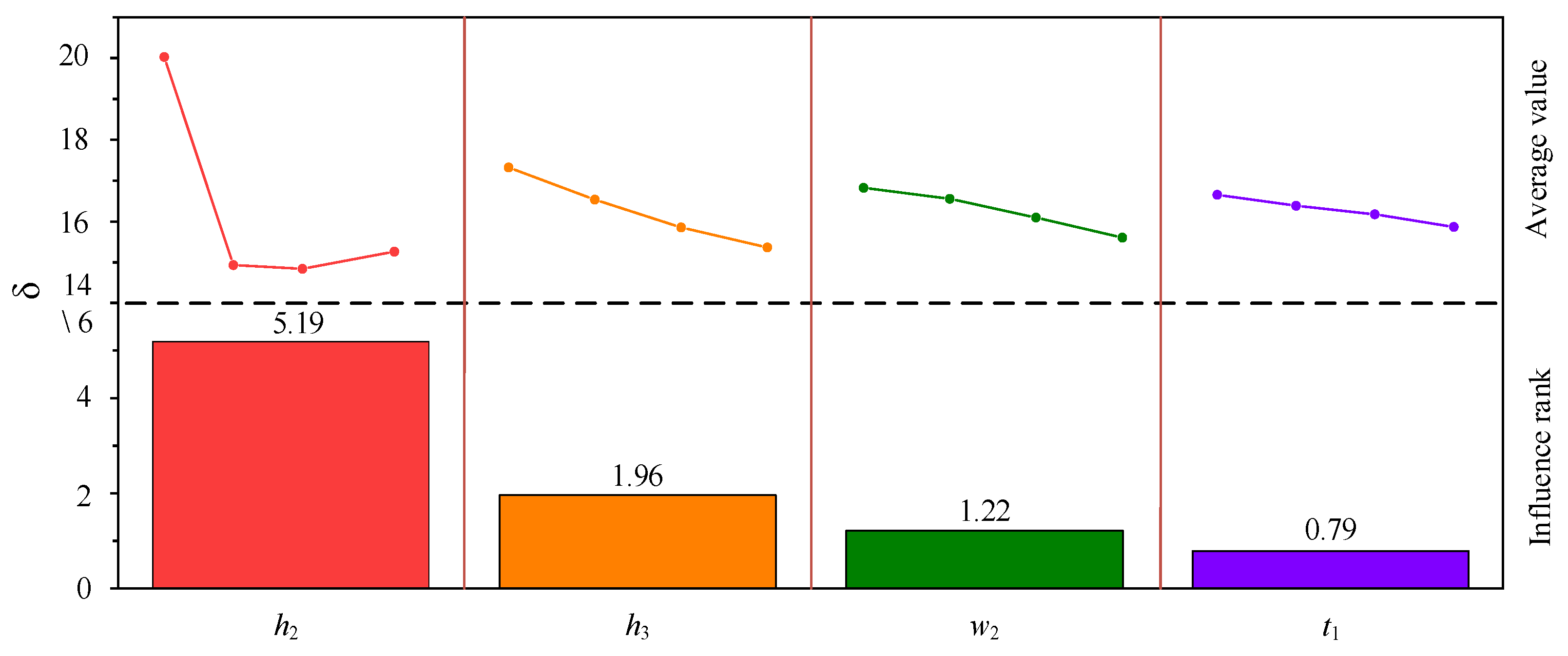



| Model | Parameters | Symbols | Value |
|---|---|---|---|
| Width | w2 | 2.5 mm | |
| Height | h2 | 5 mm | |
| Magnet | Type | N35 | 1.2 T |
| Quantity | 8 | ||
| Spacing of magnet | L | 4.5 mm | |
| Spacing | d1, d2 | 4.5 mm | |
| Width | w3 | 0.5 mm | |
| Height | t1 | 0.05 mm | |
| Coil | Lift-off distance | h3 | 0.4 mm |
| Relative permeability | μr | 1 | |
| Conductivity | σ | 5.998 × 107 S/m | |
| Relative dielectric constant | ε | 1 | |
| Thickness | D | 2 mm | |
| Mass density | ρ | 2700 kg/m3 | |
| Aluminum | Electrical conductivity | σA | 3.77 × 107 S/m |
| Young’s modulus | E | 70 × 109 Pa | |
| Passion’s ratio | μ | 0.33 |
| Factor | h2 (mm) | h3 (mm) | w3 (mm) | t1 (mm) |
|---|---|---|---|---|
| Level 1 | 4 | 0.1 | 0.25 | 0.03 |
| Level 2 | 10 | 0.2 | 0.5 | 0.07 |
| Level 3 | 16 | 0.3 | 0.75 | 0.11 |
| Level 4 | 24 | 0.4 | 1 | 0.15 |
| Factor | h2 (mm) | h3 (mm) | w3 (mm) | t1 (mm) | δ |
|---|---|---|---|---|---|
| 1 | 4 | 0.1 | 0.25 | 0.03 | 22.30 |
| 2 | 4 | 0.2 | 0.5 | 0.07 | 20.75 |
| 3 | 4 | 0.3 | 0.75 | 0.11 | 19.24 |
| 4 | 4 | 0.4 | 1 | 0.15 | 17.82 |
| 5 | 10 | 0.1 | 0.5 | 0.11 | 15.93 |
| 6 | 10 | 0.2 | 0.25 | 0.15 | 15.24 |
| 7 | 10 | 0.3 | 1 | 0.03 | 14.30 |
| 8 | 10 | 0.4 | 0.75 | 0.07 | 14.23 |
| 9 | 16 | 0.1 | 0.75 | 0.15 | 15.39 |
| 10 | 16 | 0.2 | 1 | 0.11 | 14.62 |
| 11 | 16 | 0.3 | 0.25 | 0.07 | 14.85 |
| 12 | 16 | 0.4 | 0.5 | 0.03 | 14.51 |
| 13 | 24 | 0.1 | 1 | 0.07 | 15.67 |
| 14 | 24 | 0.2 | 0.75 | 0.03 | 15.50 |
| 15 | 24 | 0.3 | 0.5 | 0.15 | 15.00 |
| 16 | 24 | 0.4 | 0.25 | 0.11 | 14.87 |
| Results | Level | Factors | |||
|---|---|---|---|---|---|
| h2 (mm) | h3 (mm) | w3 (mm) | t1 (mm) | ||
| δ | k1 | 20.03 | 17.32 | 16.82 | 16.65 |
| k2 | 14.93 | 16.53 | 16.55 | 16.38 | |
| k3 | 14.84 | 15.85 | 16.09 | 16.17 | |
| k4 | 15.26 | 15.36 | 15.60 | 15.86 | |
| R | 5.19 | 1.96 | 1.22 | 0.79 | |
| Influence rank | h2 (5.19) > h3 (1.96) w2 (1.22) > t1 (0.79) | ||||
| Preferred value | h2: 4 mm; h3: 0.1 mm; w2: 0.25 mm; t1: 0.03 mm; | ||||
| Group Number | Serial Number |
|---|---|
| 1 | 4 |
| 2 | 4, 5 |
| 3 | 3, 4, 5 |
| 4 | 3, 4, 5, 6 |
| 5 | 2, 3, 4, 5, 6 |
| 6 | 2, 3, 4, 5, 6, 7 |
Disclaimer/Publisher’s Note: The statements, opinions and data contained in all publications are solely those of the individual author(s) and contributor(s) and not of MDPI and/or the editor(s). MDPI and/or the editor(s) disclaim responsibility for any injury to people or property resulting from any ideas, methods, instructions or products referred to in the content. |
© 2023 by the authors. Licensee MDPI, Basel, Switzerland. This article is an open access article distributed under the terms and conditions of the Creative Commons Attribution (CC BY) license (https://creativecommons.org/licenses/by/4.0/).
Share and Cite
Du, L.; Gao, R.; Jia, X. Antisymmetric Lamb Wave Simulation Study Based on Electromagnetic Acoustic Transducer with Periodic Permanent Magnets. Sensors 2023, 23, 7117. https://doi.org/10.3390/s23167117
Du L, Gao R, Jia X. Antisymmetric Lamb Wave Simulation Study Based on Electromagnetic Acoustic Transducer with Periodic Permanent Magnets. Sensors. 2023; 23(16):7117. https://doi.org/10.3390/s23167117
Chicago/Turabian StyleDu, Lianren, Ruizhen Gao, and Xiaojuan Jia. 2023. "Antisymmetric Lamb Wave Simulation Study Based on Electromagnetic Acoustic Transducer with Periodic Permanent Magnets" Sensors 23, no. 16: 7117. https://doi.org/10.3390/s23167117




